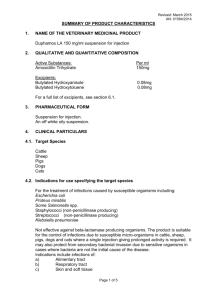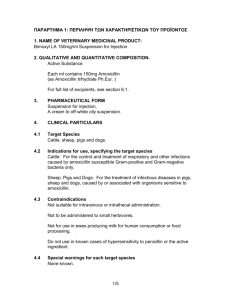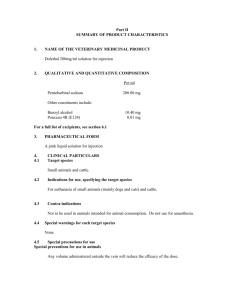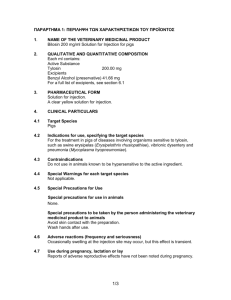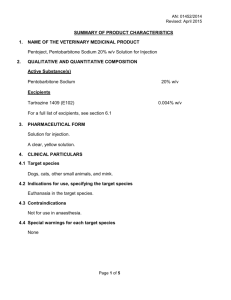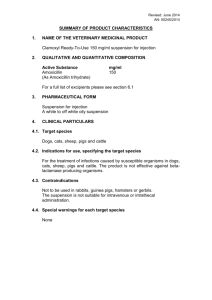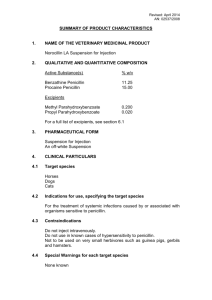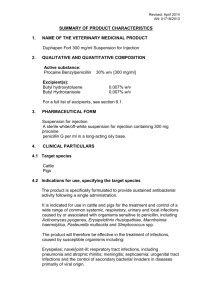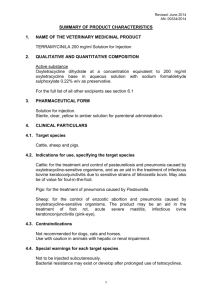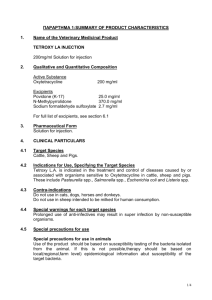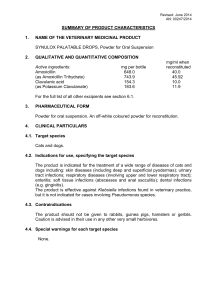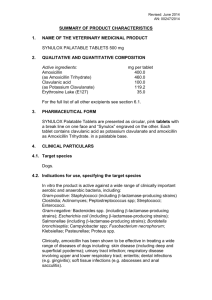AN: 00852/2014 Revised October 2014 SUMMARY OF PRODUCT
advertisement
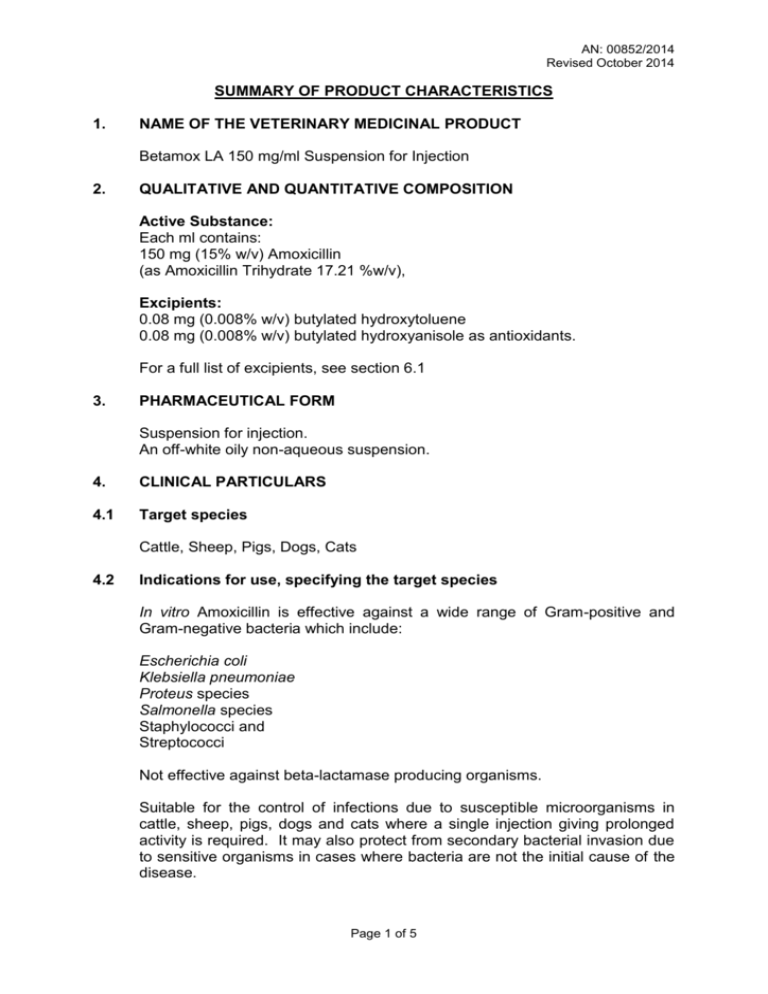
AN: 00852/2014 Revised October 2014 SUMMARY OF PRODUCT CHARACTERISTICS 1. NAME OF THE VETERINARY MEDICINAL PRODUCT Betamox LA 150 mg/ml Suspension for Injection 2. QUALITATIVE AND QUANTITATIVE COMPOSITION Active Substance: Each ml contains: 150 mg (15% w/v) Amoxicillin (as Amoxicillin Trihydrate 17.21 %w/v), Excipients: 0.08 mg (0.008% w/v) butylated hydroxytoluene 0.08 mg (0.008% w/v) butylated hydroxyanisole as antioxidants. For a full list of excipients, see section 6.1 3. PHARMACEUTICAL FORM Suspension for injection. An off-white oily non-aqueous suspension. 4. CLINICAL PARTICULARS 4.1 Target species Cattle, Sheep, Pigs, Dogs, Cats 4.2 Indications for use, specifying the target species In vitro Amoxicillin is effective against a wide range of Gram-positive and Gram-negative bacteria which include: Escherichia coli Klebsiella pneumoniae Proteus species Salmonella species Staphylococci and Streptococci Not effective against beta-lactamase producing organisms. Suitable for the control of infections due to susceptible microorganisms in cattle, sheep, pigs, dogs and cats where a single injection giving prolonged activity is required. It may also protect from secondary bacterial invasion due to sensitive organisms in cases where bacteria are not the initial cause of the disease. Page 1 of 5 AN: 00852/2014 Revised October 2014 Indications include infections of: (a) (b) (c) (d) (e) 4.3 Alimentary tract Respiratory tract Skin and soft tissue Urogenital tract and, In prevention of post-operative infection (treat before surgery). Contraindications This product is not suitable for intravenous or intrathecal use This product should not be administered to rabbits, hamsters, gerbils or guinea pigs. Not for use in known cases of hypersensitivity to penicillins or cephalosporins. 4.4 Special Warnings for each target species No special warnings. 4.5 Special precautions for use i. Special precautions for use in animals Use of the product should be based on susceptability testing of the bacteria isolated from the animal. If this is not posible, therapy should be based on local epidemiological information. ii. Special precautions to be taken by the person administering the veterinary medicinal product to animals Care should be taken to avoid accidental self-injection. In the case of accidental self-injection, seek medical advice immediately. Penicillins and cephalosporins may cause hypersensitivity (allergy) following injection, inhalation, ingestion or skin contact. Hypersensitivity to penicillins may lead to cross-reactions to cephalosporins and vice versa. Allergic reactions to these substances may occasionally be serious. 1. Do not handle this product if you know you are sensitised, or if you have been advised not to work with such preparations. 2. Handle this product with great care to avoid exposure, taking all recommended precautions. 3. If you develop symptoms following exposure such as skin rash, you should seek medical advice and show the doctor this warning. Swelling of the face, lips or eyes or difficulty with breathing, are more serious symptoms and require urgent medical attention. Page 2 of 5 AN: 00852/2014 Revised October 2014 Wash hands after use. 4.6 Adverse reactions (frequency and seriousness) Occasional local tissue reaction may result from injection. 4.7 Use during pregnancy, lactation or lay Can be safely administered during pregnancy and lactation. 4.8 Interaction with other medicinal products and other forms of interaction It is not generally recommended to use bactericidal and bacteriostatic antibiotics at the same time. 4.9 Amounts to be administered and administration route To ensure the correct dosage, bodyweight should be determined as accurately as possible to avoid underdosing. Cattle, sheep and pigs - By intramuscular injection only. Dogs and cats - By subcutaneous or intramuscular injection. The recommended dosage rate is 15 mg per kg bodyweight, repeatable if necessary after 48 hours. Massage the injection site. Shake the vial before use Swab the septum before removing each dose. Use a dry sterile needle and syringe. A separate injection site should be used for each administration. Animal Weight (kg) Dosage volume (ml) Cattle 450 kg 45.0 ml Sheep 65 kg 6.5 ml Pigs 150 kg 15.0 ml Dogs 20 kg 2.0 ml Cats 5 kg 0.5 ml Dose volume is equivalent to 1 ml per 10 kg bodyweight. If dose volume exceeds 20 ml, it should be divided and injected into two sites. As with other injectable preparations normal aseptic precautions should be observed. An appropriately graduated syringe must be used to allow accurate administration of the required dose volume. This is particularly important when injecting small volumes. 4.10 Overdose (symptoms, emergency procedures, antidotes), if necessary Penicillins have a wide safety margin. Page 3 of 5 AN: 00852/2014 Revised October 2014 4.11 Withdrawal period Milk for human consumption must not be taken from a cow during treatment. With cows milked twice daily, milk for human consumption may only be taken from 79 hours (i.e. at the 7th milking) after the last treatment. With other dosing routines, the basis of the veterinary surgeons advice should be that milk may be taken for human consumption only after the same period from the last treatment (i.e. with three times a day milking, milk for human consumption may only be taken at the 10th milking). Cattle (meat): 23 days from the last treatment. Sheep and pigs (meat): 16 days from the last treatment. Not for use in sheep producing milk for human consumption. 5. PHARMACOLOGICAL PROPERTIES Pharmacotherapeutic group: Antibacterial ATC Vet Code: QJ01CA04 5.1 Pharmacodynamic properties Amoxicillin predominately inhibits cell wall synthesis in susceptible bacteria. Amoxicillin has a unique mode of action which directly and irreversibly disrupts existing cell wall peptidoglycan rather than newly forming peptidoglycan of the divisory septal wall as with other members of the penicillin family. 6. PHARMACEUTICAL PARTICULARS 6.1 List of excipients Butylated Hydroxyanisole Butylated Hydroxytoluene Aluminium Stearate Propylene Glycol Dicaprylocaprate 6.2 Incompatibilities None known 6.3 Shelf life Shelf life of the veterinary medicinal product as packaged for sale: 2 years. Shelf life after first opening the immediate packaging: 28 days Page 4 of 5 AN: 00852/2014 Revised October 2014 6.4 Special precautions for storage Do not store above 25ºC. Protect from light. Following withdrawal of the first dose, use the product within 28 days. Discard unused material. This product does not contain an antimicrobial preservative. 6.5 Nature and composition of immediate packaging 100 ml and 50 ml clear, colourless Type II or III multidose glass vials, closed with nitrile rubber bungs and aluminium overseals. 50 ml, 100 ml, 250 ml and 500 ml clear polyethylene terephthalate vials sealed with nitryl bungs and aluminium overseals. 6.6 Special precautions for the disposal of unused veterinary medicinal product or waste materials derived from the use of such products Any unused veterinary medicinal product or waste materials derived from such veterinary medicinal products should be disposed of in accordance with local requirements. 7. MARKETING AUTHORISATION HOLDER Norbrook Laboratories Limited Station Works Camlough Road Newry Co. Down BT35 6JP Northern Ireland 8. MARKETING AUTHORISATION NUMBER Vm 02000/4070 9. DATE OF FIRST AUTHORISATION Date: 30 July 1986 10. DATE OF REVISION OF THE TEXT Date: October 2014 APPROVED Page 5 of 5 23/10/14
